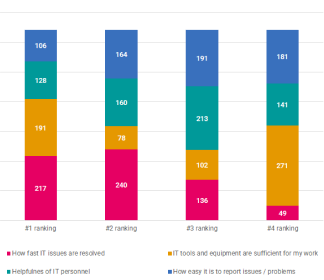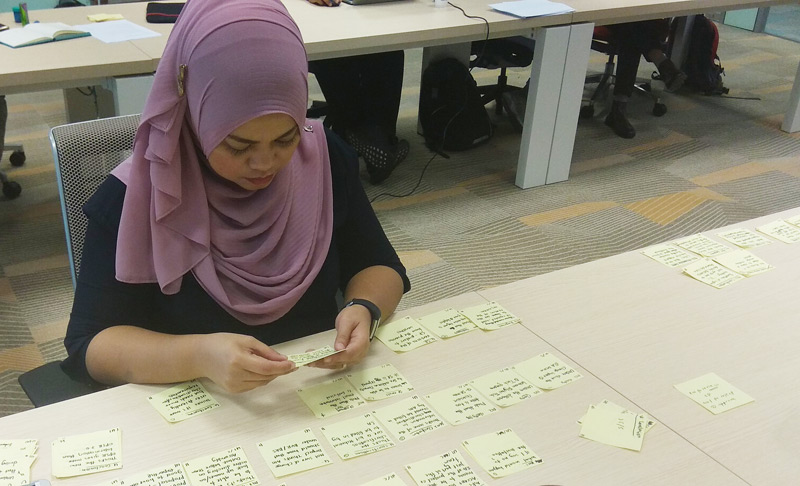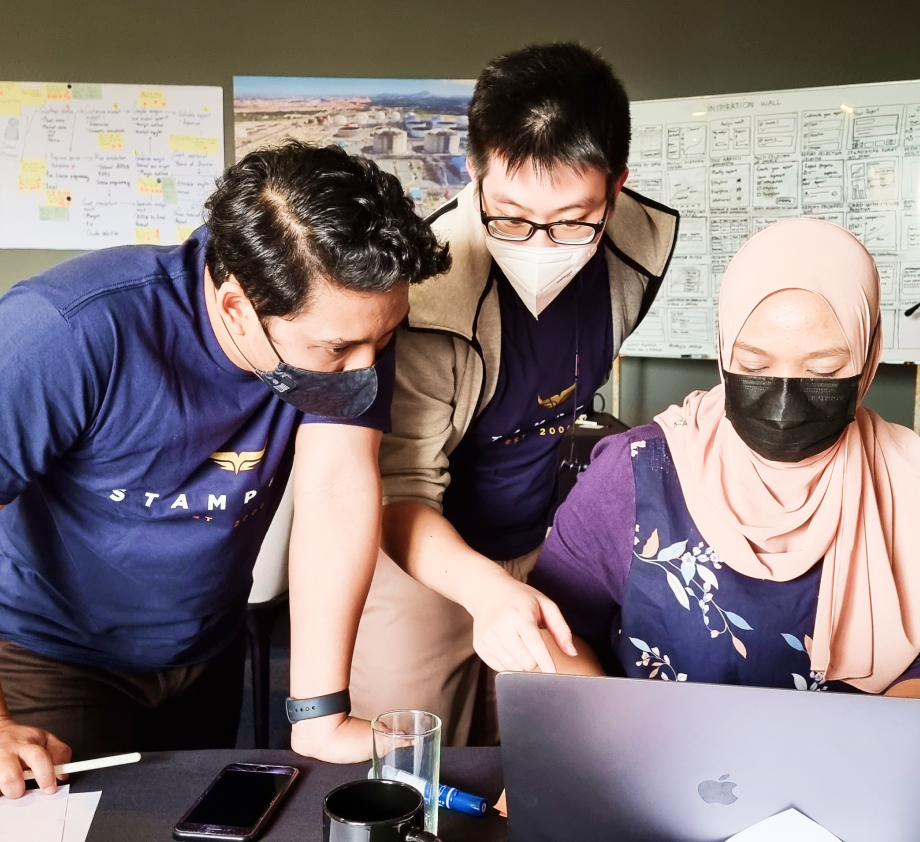UX strategy
User experience strategy lies at the intersection of UX design and business strategy. It defines how the organisation wants its customers to experience brand and product interactions. It serves as a guide throughout the product design and product development effort, helping everyone focus on what really matters so that they can make better decisions together.
UX strategy holds high importance to organisations, as encapsulated by Jeff Bezos, who famously said, “Obsessing over customer experience is the only long-term defensible competitive advantage”.
In UX, everything begins with empathy. A UX strategy is unique to your business, and to do that, we work closely with stakeholders to understand the organisational aspirations and strategy. By having conversations with people at various levels, we can also learn about the organisational culture, its capabilities and functions and processes. On the outside, we also take a look at customer satisfaction and the impact the organisation is having on society.
To design the desired future experience, we need to first take stock of the environment that the future is to thrive in. We collaborate closely with subject matter experts from various disciplines like business, technology, customer service and others, inviting them into our design process to map the ecosystem in which these touchpoints will operate and deliver their value. This would then allow us to identify existing or new areas of impact where UX can be instrumental in clearing uncertainty and helping businesses make informed decisions.
A UX strategy is incomplete without its users. At the very core of the strategy sits a constellation of users, each singular in motivation, behaviours and needs. The strategy will next guide the user research execution process, from planning to recruitment and insights-making, serving as the tether that connects business and design.
User research
User research helps businesses understand the needs, behaviours, and attitudes of users. Findings and insights from this research can be used to make product and service decisions more confidently.
There are generally two types of research that can be of service to business: generative and evaluative. We use generative research to help define the problem so you can solve it better. It is often used when not much is known about a particular area, and some exploration is necessary before introducing a solution or innovation to a customeraddress pain point.
We use evaluative research to assess how well an existing product or service or improvements to them are working out. It can confirm if there is a problem and tells us what causes it. At Stampede, we practice outcome-oriented research that goes several steps further beyond problem identification by giving actionable insights and translating that into product opportunities.
The effort and time needed for research depend on the complexity of user questions that the product team needs to be answered. Defining a persona that is very familiar to the team could take a few hours, while recruiting and interviewing a new, lesser known persona with more nuances may take a few weeks. As a product company ourselves, we understand very well that speed-to-market is essential. When it comes to research, our priority is to plan well ahead, and be razor-sharp with execution while ensuring the research integrity and confidence remain intact.
Let’s take a brief look at several research methods we have used to help businesses make more informed decisions.
Persona definition and empathy map
Though not strictly a research method, persona definition is a sensible way to start any UX process because it creates a loose but effective portrait of the user. This persona definition can come from two sources: findings about the user from an earlier exploratory research or based on what the team assume they know about the user. We will then document their goal, motivations, frustrations and other relevant sensory experience into an empathy map canvas.
A persona defined without validating them with real users is akin to building a house of cards, incurring product UX debt. We use the following research methods to confirm what we thought we knew of the user. Once this is validated, the product team and make decisions about the user from a place of certainty and data-informed.
User recruitment
Stampede works closely with the product team to identify users to recruit for research based on the persona. Most product teams already have a database of existing customers to recruit from, or a platform, be it through marketing or social media, where they can source new users from. Stampede will help with screening candidate users to ensure that they fit the criteria and are representative of the persona. Where the user criteria are more unique, we will work with a recruitment partner to seek out these users.
User interviews
User interviews are great for validating our understanding of the user, yielding rich and reliable insights.
Each interview session allows us to understand the motivation behind the user’s behaviour, digging deep into specific pain points they may have. With good research planning, it also can be done efficiently, fueling the team’s product discovery momentum instead of slowing it down.
Interviews can happen remotely or in person. Remote user interviews, the game-changer that enabled us to continue making product research possible during the pandemic, have now allowed us to expand the coverage of our users to other countries and time zones where the user feels most comfortable. In-person interviews, even with limits to its reach, do give us a great opportunity to have the user in a controlled environment where we can ensure an optimum interview experience. Beyond the logistical differences, both methods are just as effective.
Our user interview sessions are between one interviewer and one user at a given time. This gives a great opportunity for the interviewer to explore a topic deeply and for the user to be comprehensive and candid about their thoughts. As the interview unfolds, the interview data is captured by a notetaker behind the scene. This pairing allows us to identify and follow through on patterns and insightful gems right away without having to resort to traditional transcription later.
Contextual inquiry
There are instances where an interview in an artificial setting, such as a test room, may limit you from having a better understanding of how environmental factors affect the user experience. Contextual inquiry helps this understanding by observing users in their natural environment, providing real-time, context-rich insight into their behaviours and interactions with a product or service.
Think of checking into a hotel and how the layout and furnishing of the lobby, the luggage services, the reception location, the lighting and all factor into how the user is interacting with the reservation system. There’s so much that an in-person observation of how the user interacts with a product or service can give us a richer contextual understanding.
Surveys and questionnaires
While qualitative methods like user interviews can answer the Why questions, at times, the problem space can be so broad that we need to employ a quantitative method to first determine the magnitude of the problem, its persistency and what and who it impacts. Having this birds-eye view then allows us to focus our attention to a specific problem area and start asking qualitative questions.
Surveys are among the most common way to gather data quantitatively, but also, ironically, the hardest to get right. Most product teams are drawn to surveys because it’s the easiest to set up, but they rarely find the results useful or informative enough to guide their way forward. Find out how we designed, stress-tested and promoted inclusivity in our surveys to successfully draw insights from 4,000 employees as part of our organisational research for Chr Hansen.
Tree testing
Interface intuitiveness doesn’t happen by chance. If you’ve used an app and somehow know where things are from the get-go, that intuitiveness right there is an intentionally designed experience.
When it comes to information, card sorting helps you organize them, while tree testing helps you understand if the way the information is organized makes sense to the user. There are many examples and rule of thumb around how to organise information, but we have found tree testing to be a superior method for teams to evaluate the hierarchy and findability of topics in a website or application.
Tree testing can be done for information on an existing website or very early in the design process for new websites or applications. It’s almost always done as an automated, remote process, where you send the link to your tree to a sufficient sample size and wait for the results. This can prove to be less useful as you don’t get the qualitative data that could show you why your testers are having the problems they are. Find out how Stampede makes tree testing yield better qualitative result by expanding it each test with a moderated segment.
Empathy session
At Stampede, we believe that what is researched today can serve as excellent secondary research for another team tomorrow. This is the reason we meticulously catalogue and document our findings, from raw data to videos and anecdotes and verbatim quotes, in a comprehensive report for the product team to consume. Our report covers the product goal, research plan, execution, research findings, insights and opportunities and lastly, informed recommendation to the product team.
We would then present a condensed version of this report to the entire product team and their stakeholders to inspire empathy for the user and a shared understanding of their mindset, behaviour and pain points. These Empathy Sessions are key in communicating critical findings about the user and have a transformative effect in putting the user at the centre.
It also usually marks the end of the UX research stage and the passing of the baton to the Design Sprint team for product validation or the Delivery stage for product execution.










